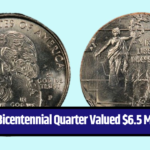The world of rare coins is a fascinating intersection of history, art, and economics, where each piece tells a unique story of its era. Among these treasures, coins like the Bicentennial Quarter and other legendary specimens stand out, reaching staggering valuations due to their rarity, craftsmanship, and historical importance. Below, we explore seven remarkable coins valued at $33 million or more, each with an extraordinary tale to tell.
Bicentennial Quarter: A Commemorative Gem

- Year: 1976
- Value: $33 million
- Unique Feature: Struck on a 90% silver planchet by error
Released to honor America’s 200th anniversary of independence, most Bicentennial Quarters carry only face value. However, a rare variant, accidentally struck on a 90% silver planchet, sold for an astounding $33 million. This coin’s near-perfect condition and unique error make it a collector’s dream.
1913 Liberty Head Nickel: A Coin of Mystery

- Year: 1913
- Value: $50 million+
- Unique Feature: Only five known specimens
The Liberty Head Nickel is shrouded in mystery, as it was never officially released by the U.S. Mint. Only five examples exist, making it one of the rarest coins in the world. Among them, the Eliasberg specimen stands out for its impeccable condition, further elevating its value to over $50 million.
1794 Flowing Hair Silver Dollar: America’s First Dollar Coin

- Year: 1794
- Value: $60 million
- Unique Feature: First silver dollar minted in the U.S.
This historic coin is widely believed to be the first silver dollar produced by the U.S. Mint. Its design, condition, and significance in U.S. monetary history have propelled its value to $60 million, setting a record as one of the highest auctioned coins in the world.
1933 Double Eagle: A Tale of Survival

- Year: 1933
- Value: $75 million
- Unique Feature: Recalled and melted by the U.S. government
The 1933 Double Eagle holds a dramatic backstory. During the Great Depression, the U.S. government decided to melt these twenty-dollar gold coins to stabilize the economy. A few escaped destruction, and their scarcity, coupled with their historical intrigue, has made them exceptionally valuable, with one fetching $75 million at auction.
1787 Brasher Doubloon: A Goldsmith’s Legacy

- Year: 1787
- Value: $80 million
- Unique Feature: Among the earliest U.S. gold coins, stamped with “EB”
The Brasher Doubloon, crafted by goldsmith Ephraim Brasher, is a symbol of early American minting ingenuity. Featuring Brasher’s distinctive “EB” counterstamp, its rarity and historical importance place its value at an estimated $80 million, making it one of the most iconic coins from the era.
1343 Edward III Florin: A Medieval Treasure

- Year: 1343
- Value: $100 million
- Unique Feature: Only three known to exist
Also known as the Double Leopard, the Edward III Florin is one of the earliest gold coins in English history. Its rarity and medieval origins make it a true masterpiece, with only three known specimens surviving today. Its value is estimated at an astonishing $100 million, reflecting its unparalleled historical significance.
1849 Double Eagle: The Pinnacle of Numismatics

- Year: 1849
- Value: $120 million
- Unique Feature: One-of-a-kind coin from the California Gold Rush
The 1849 Double Eagle is not just a coin—it’s a symbol of the California Gold Rush. As the first twenty-dollar gold piece minted by the U.S., it holds immense historical weight. Its status as a one-of-a-kind artifact elevates its value to an unparalleled $120 million, cementing its place as the most valuable coin ever minted.
Rare Coins: Timeless Artifacts of History
Rare coins go beyond their material value, offering a window into history, culture, and the artistry of their time. From minting errors to groundbreaking designs, these coins represent pivotal moments and stories that continue to captivate collectors and enthusiasts. Whether it’s a silver dollar from the birth of the U.S. Mint or a medieval English relic, these treasures remind us of the rich tapestry of human history.
FAQs:
What makes a coin valuable?
Rarity, historical significance, condition, and unique features such as minting errors are key factors determining a coin’s value.
Why is the 1933 Double Eagle so rare?
The U.S. government melted nearly all 1933 Double Eagles during the Great Depression, leaving only a few surviving coins.
How can I determine if my coin is rare?
Consult a professional numismatist or have your coin graded by a reputable organization such as PCGS or NGC.
Are these coins on display?
Many of these coins are held in private collections, though some have been exhibited in museums or auctions.










